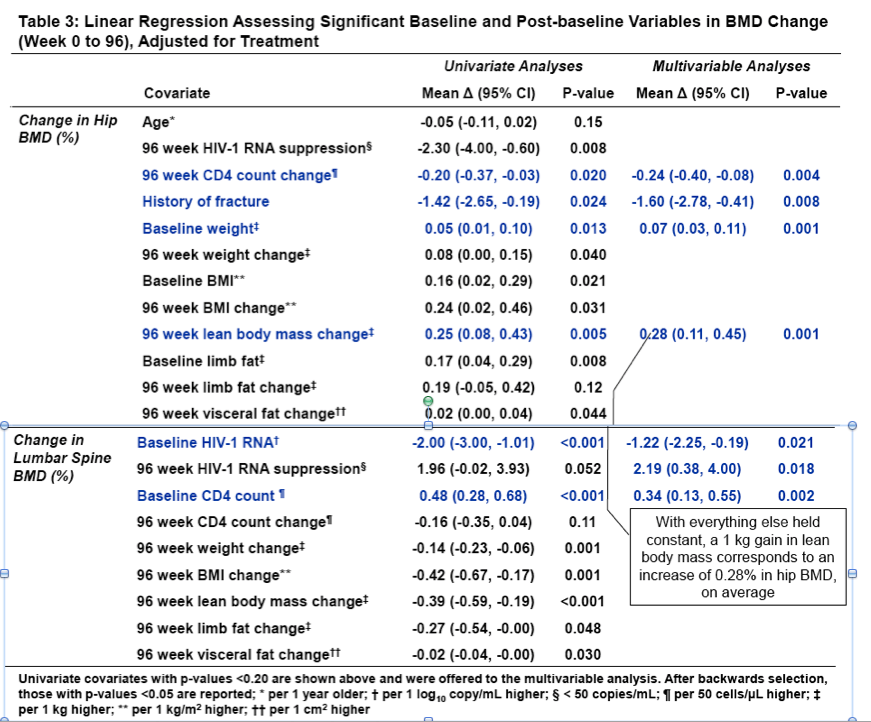 |
 |
 |
| |
Change in Lean Body Mass and Association with Bone Mineral Density Change in Subjects Randomized to ABC/3TC or TDF/FTC with ATV/r or EFV: AIDS Clinical Trials Group A5224s, a substudy of ACTG A5202
|
| |
| |
Reported by jules Levin
CROI 2013
Kristine M Erlandson1, Douglas Kitch2, Camlin Tierney2, Paul E Sax3, Eric S Daar4, Pablo Tebas5, Kathleen Melbourne6, Belinda Ha7, Nasreen C Jahed8, Grace A McComsey9 1University of Colorado-Anschutz Medical Campus, Aurora, CO, USA; 2Harvard School of Public Health, Boston, MA, USA; , 3Brigham and Women's Hospital and Harvard Medical School, Boston, MA, USA; 4Los Angeles Biomedical Research Institute at Harbor-UCLA Medical Center, Torrance, CA, USA; 5University of Pennsylvania, Philadelphia, PA, USA; 6Gilead Sciences, Foster City, CA; 7GlaxoSmithKline, Research Triangle, NC, USA; 8Social & Scientific Systems, Inc., Silver Spring, MD, USA; 9Case Western Reserve University, Cleveland, Ohio, USA

ABSTRACT
BACKGROUND: Greater lean body mass (LBM) and fat mass augment bone mineral density (BMD) through mechanical loading and are associated with lower risk of fracture. The effect of individual antiretroviral therapy (ART) regimens on LBM and the contribution of body composition components to BMD change with ART initiation have not been well defined.
METHODS: A5202 prospectively randomized 1857 ART-naïve HIV+ subjects to blinded abacavir/lamivudine (ABC/3TC) vs tenofovir disoproxil fumarate/emtricitabine (TDF/FTC) with open-label efavirenz (EFV) or atazanavir/ritonavir (ATV/r). Substudy A5224s compared changes in BMD, LBM, limb fat by dual-energy X-ray absorptiometry and visceral fat by computed tomography. Statistical analyses included 2-sample t-tests and linear regression and were intent-to-treat. Covariates included ART regimen, sex, age, race/ethnicity, baseline and 96-week change in CD4 count and HIV-1 RNA, hepatitis C, history of bone fracture, and baseline and 96-week change in body weight, body mass index (BMI), LBM, limb and visceral fat.
RESULTS: A5224s included 269 subjects: 85% male, 48% white non-Hispanic, median age 39 years, HIV-1 RNA 4.5 log10 copies/mL, CD4 240 cells/mm3. Overall, weight increased by a mean 4.8 kg, BMI by 1.5 kg/m2, and LBM by 1.4 kg at 96 weeks (all p<0.001).
Assignment to ATV/r (vs EFV) resulted in greater gain in weight (kg) (2.63; 95% CI 0.35, 4.92, p=0.02), BMI (kg/m2) (0.88; CI 0.13, 1.62 p=0.02), but not LBM (kg) (0.67; CI -0.24, 1.59; p=0.15). No significant differences were seen between ABC/3TC and TDF/FTC (p≥0.10).
In multivariate analysis including ART regimen, sex, age, race/ethnicity, and baseline CD4 and HIV-1 RNA, only lower CD4 count and higher HIV-1 RNA were associated with greater increase in weight and BMI (all p≤0.002), and low CD4 count with greater increase in LBM(p<0.001). Exploratory multivariate analyses to identify significant factors associated with change in hip or lumbar spine BMD were performed. In addition to ART and HIV characteristics, gain in LBM but not fat attenuated loss of hip BMD.
CONCLUSIONS: Overall, similar gains in weight, BMI, and LBM were observed after ART initiation with ABC/3TC and TDF/FTC. ATV/r vs EFV resulted in greater gain in weight and BMI but not LBM. Lower CD4 was associated with greater gain in weight, BMI and LBM. Gain in LBM but not fat attenuated loss of hip BMD after ART.







|
| |
|
 |
 |
|
|